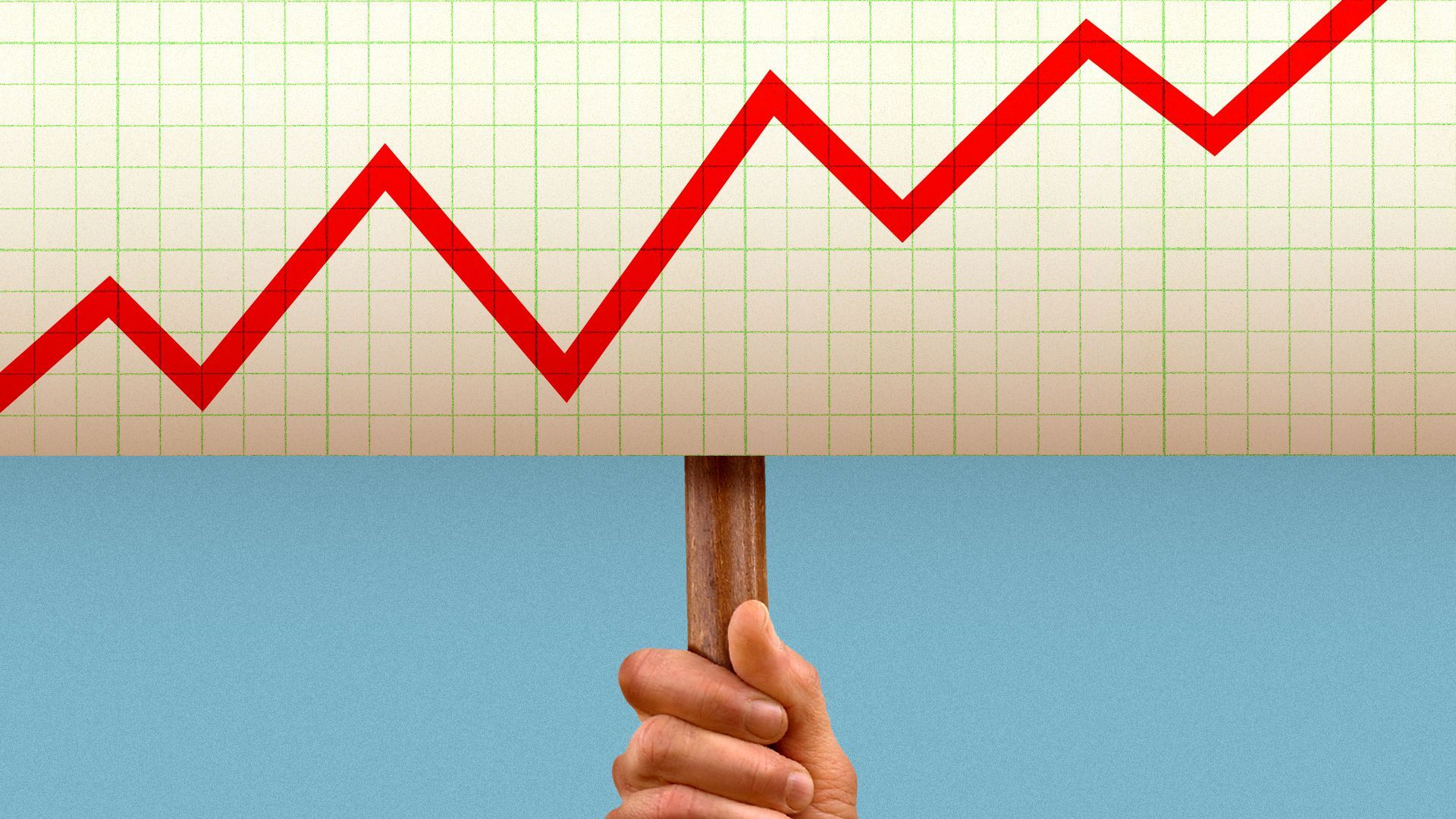| | | | | | | Presented By SmartAsset | | | | Axios Markets | | By Emily Peck and Matt Phillips · Dec 19, 2022 | | 🌅 Happy Monday and happy Hanukkah. We woke up just as Elon Musk's Twitter poll closed. The news: A majority of respondents said he should step down as "head" of Twitter. Today's newsletter is 1,175 words, 4.5 minutes. | | | | | | 1 big thing: Worker strikes surged in 2022 |  | | | Illustration: Shoshana Gordon/Axios | | | | There were 374 worker strikes started in 2022 — a 39% increase over 2021, according to a database run by Cornell, Emily writes. Why it matters: Fueled partly by anger over working conditions in the pandemic and spurred on by other labor wins, all sorts of workers — warehouse employees, teachers, nurses, graduate students, journalists — walked off the job. - Many others voted to unionize — including at more than 260 Starbucks stores in the past year — demanding better pay and working conditions.
- Over the weekend, the University of California reached a tentative agreement with around 36,000 employees that would end the year's biggest strike, and provide some workers with wage increases of as much as 55%.
The big picture: The low unemployment rate and worker shortage gave workers more leverage. "But that's not the whole story," said Johnnie Kallas, project director of Cornell-ILR Labor Action Tracker. - Many workers' concerns centered around health and safety and understaffing — a major point of contention for nurses who walked out in 2022, he said.
- "It's obvious why health care workers would be burned out after working through a global pandemic, but I think [burnout's] also extended to places like accommodation and food services," said Kallas.
- Higher profile organizing efforts at big companies, particularly Starbucks and Amazon, have increased momentum for action more broadly this year.
- "Energetic organizing is contagious — people see that progress is possible," said Ana Avendaño, a law professor at CUNY who specializes in labor. More support from a pro-labor NLRB helped, too, she said.
Plus: With rising inflation, workers want bigger raises than employers typically give. Context: Strikes were on the rise, even before the pandemic — hitting a 17-year high in 2019, when 25 major work stoppages occurred, per BLS data, which only counts stoppages of 1,000 workers or more. (Cornell's tracker, started in late 2020, covers all collective actions.) - According to Cornell, approximately 78,000 workers walked off the job in the first half of 2022, compared with 26,500 in the first half of 2021.
Details: The highest-profile strikes of the year, including UC's, happened in the second half: - 15,000 nurses in Minnesota in September walked out for three days in what is believed to be the largest private-sector nurse strike in U.S. history.
- Workers at more than 100 Starbucks stores participated in a one-day work stoppage that organizers called "the Red Cup Rebellion" in November.
What to watch: Next year will be pivotal. Employees at Starbucks, Amazon and a few other places who voted to unionize will need to negotiate labor contracts with employers who've so far been staunchly resistant to organization. - Plus, the labor contract for 350,000 UPS workers expires in July 2023. Depending on how negotiations go for a new contract, this could be "next year's biggest strike."
Go deeper with "Axios Today": A remarkable year for organized labor in the U.S. |     | | | | | | 2. Catch up quick | | ⚖️ Sam Bankman-Fried is scheduled to appear in court today; expected to drop extradition fight. (CNN) ✨ European Commission charges Meta with antitrust violations. (WSJ) 🇪🇺 EU energy ministers near deal on gas price cap. (FT) |     | | | | | | 3. 🇨🇳 Always buy on the bailout |  | | | A residential development in Shanghai. Photo: Qilai Shen/Getty Images | | | | Prices for bonds of China's heavily indebted — and financially wobbly — homebuilders have soared in recent weeks, Matt writes. Why it matters: The rally — spotlighted by the Wall Street Journal — suggests investors think China's economic troubles are so great that the government has no choice but to keep supporting key players in the residential real estate market. - From the traders' perspective, that means bonds of companies that were near bankruptcy will keep making payments to investors. Therefore that paper — recently considered nearly worthless — is quite valuable again.
Flashback: In the fall of 2021, China Evergrande, one of the country's largest housing developers, started running short of cash to pay creditors, setting off a financial crisis among other real estate developers amid a downturn in the housing market. - The fact that the government ultimately allowed Evergrande to default raised questions among investors, some of whom presumed these companies had implicit backing from the government.
- They then dumped bonds of Chinese homebuilders, in droves.
The big picture: Homebuilding — and related industries — accounts for between 25% and 30% of China's GDP, analysts have recently estimated. The bottom line: A longstanding tactic among traders worldwide is to buy what governments are bailing out. That trade is clearly working here. |     | | | | | | A message from SmartAsset | | This billion-dollar startup wants to help you retire | | |  | | | | SmartAsset developed a free wealth management solution that's helping thousands of Americans control their plan to retirement. Whether you're in your golden years or just looking to get ahead, our no-cost tool will match you with up to 3 vetted financial advisors serving your area. Get started. | | | | | | 4. 📈 Bond bounce in China |  Data: ICE Asian Dollar High Yield Corporate China Issuers Index; Chart: Axios Visuals Betting on a bailout: Returns on an index of Chinese junk bonds — a category dominated by developers — were roughly 29% over the last month, according to ICE Data Services, Matt writes. |     | | |  | | | | If you like this newsletter, your friends may, too! Refer your friends and get free Axios swag when they sign up. | | | | | | | | 5. The trajectory of a sleeper hit |  Data: Luminate; Chart: Axios Visuals The second most-streamed song of 2022 in the U.S., at least through Dec. 1, was "Heat Waves," by English group Glass Animals. (The top song was by Harry Styles, who's also English; we're clearly better at pop music than we are at soccer), Axios' Felix Salmon writes. Why it matters: "Heat Waves" racked up 493 million U.S. streams in the first 11 months of this year, per Luminate, which powers the Billboard charts — on top of the 583 million streams it had already accumulated to that point. Between the lines: "Heat Waves" didn't look like a megahit upon its release. By the end of its first full week on streaming platforms, it had managed 2.3 million U.S. streams — certainly respectable, but nothing earth-shattering. - "As It Was," by contrast, the Harry Styles hit, came out of the gate with 42 million streams; "Anti-Hero", a new song by Taylor Swift, did even better with 51 million. It took "Heat Waves" six full months to get to that point.
- "Heat Waves" only really became a megahit after a snippet of it became ubiquitous on TikTok. As such, it's a prime example of how a song that almost no one loves can become huge — just thanks to social media.
The big picture: It's not uncommon for a song to reach 1 billion U.S. cumulative streams, as "Heat Waves" did in September. Many other songs have done so, including "Don't Stop Believin,'" by Journey, which was released in 1981 and is still in the 200 most-streamed songs of 2022. - That's the thesis behind a JKBX, a new service aimed at individual investors, allowing them to buy fractionalized royalty streams of hit songs. That market was very hot last year when interest rates were low, but has slowed dramatically now that future cash flows are in lower demand.
The bottom line: The biggest hit songs have very long legs, even when, as in the case of "Heat Waves," they're painfully bland. That's why the song catalogs of aging rockers like Bob Dylan or Bruce Springsteen are still worth hundreds of millions of dollars today. |     | | | | | | A message from SmartAsset | | 5 signs it could be time to fire your advisor | | |  | | | | When trying to build wealth, working with a financial advisor could be a smart move. Sadly, not all advisors have your best interest in mind — but there are 5 signs it may be time to fire yours and find a new one. An example: - They aren't a fiduciary
- They don't explain the numbers.
See the other 3. | | | | Was this email forwarded to you? Sign up here to get Axios Markets in your inbox. Today's newsletter was edited by Kate Marino and copy edited by Mickey Meece. |  | | Why stop here? Let's go Pro. | | | | | | Axios thanks our partners for supporting our newsletters. If you're interested in advertising, learn more here.
Sponsorship has no influence on editorial content. Axios, 3100 Clarendon Blvd, Arlington VA 22201 | | | You received this email because you signed up for newsletters from Axios.
Change your preferences or unsubscribe here. | | | Was this email forwarded to you?
Sign up now to get Axios in your inbox. | | | | Follow Axios on social media:    | | | | | |












No comments:
Post a Comment